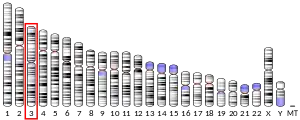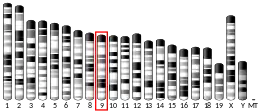Collagen, type VII, alpha 1
Collagen alpha-1(VII) chain is a protein that in humans is encoded by the COL7A1 gene.[5]
Function
This gene encodes the alpha chain of type VII collagen. The type VII collagen fibril, composed of three identical alpha collagen chains, is restricted to the basement zone beneath stratified squamous epithelia. It functions as an anchoring fibril between the external epithelia and the underlying stroma. Mutations in this gene are associated with all forms of dystrophic epidermolysis bullosa.[6] In the absence of mutations, however, an autoimmune response against type VII collagen can result in an acquired form of this disease called epidermolysis bullosa acquisita.[7]
Type VII collagen is also found in the retina; its function in this organ is unknown.[8]
COL7A1 is located on the short arm of human chromosome 3, in the chromosomal region denoted 3p21.31. The gene is approximately 31,000 base pairs in size and is remarkable for the extreme fragmentation of its coding sequence into 118 exons.[9][10] COL7A1 is transcribed into an mRNA of 9,287 base pairs.[11] In the skin, the type VII collagen protein is synthesized by keratinocytes and dermal fibroblasts.[12]
The symbol for the orthologous gene in the mouse is Col7a1.
Clinical significance
The inherited disease, dystrophic epidermolysis bullosa, is caused by recessive or dominant mutations in COL7A1.[13]
Epidermolysis bullosa acquisita involves an autoimmune reaction to this form of collagen.[14]
Interactions
Collagen, type VII, alpha 1 has been shown to interact with Laminin 5[15] and Fibronectin.[16][17]
See also
References
- GRCh38: Ensembl release 89: ENSG00000114270 - Ensembl, May 2017
- GRCm38: Ensembl release 89: ENSMUSG00000025650 - Ensembl, May 2017
- "Human PubMed Reference:". National Center for Biotechnology Information, U.S. National Library of Medicine.
- "Mouse PubMed Reference:". National Center for Biotechnology Information, U.S. National Library of Medicine.
- Parente MG, Chung LC, Ryynänen J, Woodley DT, Wynn KC, Bauer EA, Mattei MG, Chu ML, Uitto J (August 1991). "Human type VII collagen: cDNA cloning and chromosomal mapping of the gene". Proceedings of the National Academy of Sciences of the United States of America. 88 (16): 6931–5. Bibcode:1991PNAS...88.6931P. doi:10.1073/pnas.88.16.6931. PMC 52207. PMID 1871109.
- Bardhan A, Bruckner-Tuderman L, Chapple IL, Fine JD, Harper N, Has C, et al. (September 2020). "Epidermolysis bullosa". Nature Reviews. Disease Primers. 6 (1): 78. doi:10.1038/s41572-020-0210-0. PMID 32973163. S2CID 221861310.
- "COL7A1 collagen, type VII, alpha 1 (epidermolysis bullosa, dystrophic, dominant and recessive)". NCBI Entrez Gene database.
- Ponsioen TL, van Luyn MJ, van der Worp RJ, van Meurs JC, Hooymans JM, Los LI (September 2008). "Collagen distribution in the human vitreoretinal interface". Investigative Ophthalmology & Visual Science. 49 (9): 4089–95. doi:10.1167/iovs.07-1456. PMID 18450587.
- Christiano AM, Hoffman GG, Chung-Honet LC, Lee S, Cheng W, Uitto J, Greenspan DS (May 1994). "Structural organization of the human type VII collagen gene (COL7A1), composed of more exons than any previously characterized gene". Genomics. 21 (1): 169–79. doi:10.1006/geno.1994.1239. PMID 8088784.
- "COL7A1 genomic sequence". NCBI Entrez Nucleotide Database. 17 May 2004.
- "COL7A1 mRNA sequence". NCBI Entrez Nucleotide Database. 15 September 1995.
- Online Mendelian Inheritance in Man (OMIM): COL7A1 - 120120
- Dang N, Murrell DF (July 2008). "Mutation analysis and characterization of COL7A1 mutations in dystrophic epidermolysis bullosa". Experimental Dermatology. 17 (7): 553–68. doi:10.1111/j.1600-0625.2008.00723.x. PMID 18558993. S2CID 32600295.
- Helen Chapel; Mansel Haeney; Siraj Misbah (2006). Essentials of clinical immunology. Wiley-Blackwell. pp. 207–. ISBN 978-1-4051-2761-5. Retrieved 25 June 2010.
- Rousselle P, Keene DR, Ruggiero F, Champliaud MF, Rest M, Burgeson RE (August 1997). "Laminin 5 binds the NC-1 domain of type VII collagen". The Journal of Cell Biology. 138 (3): 719–28. doi:10.1083/jcb.138.3.719. PMC 2141627. PMID 9245798.
- Lapiere JC, Chen JD, Iwasaki T, Hu L, Uitto J, Woodley DT (November 1994). "Type VII collagen specifically binds fibronectin via a unique subdomain within the collagenous triple helix". The Journal of Investigative Dermatology. 103 (5): 637–41. doi:10.1111/1523-1747.ep12398270. PMID 7963647.
- Chen M, Marinkovich MP, Veis A, Cai X, Rao CN, O'Toole EA, Woodley DT (June 1997). "Interactions of the amino-terminal noncollagenous (NC1) domain of type VII collagen with extracellular matrix components. A potential role in epidermal-dermal adherence in human skin". The Journal of Biological Chemistry. 272 (23): 14516–22. doi:10.1074/jbc.272.23.14516. PMID 9169408.
Further reading
- Mecklenbeck S, Hammami-Hauasli N, Höpfner B, Schumann H, Kramer A, Küster W, Bruckner-Tuderman L (March 1999). "Clustering of COL7A1 mutations in exon 73: implications for mutation analysis in dystrophic epidermolysis bullosa". The Journal of Investigative Dermatology. 112 (3): 398–400. doi:10.1046/j.1523-1747.1999.00518.x. PMID 10084325.
- Dang N, Klingberg S, Marr P, Murrell DF (June 2007). "Review of collagen VII sequence variants found in Australasian patients with dystrophic epidermolysis bullosa reveals nine novel COL7A1 variants". Journal of Dermatological Science. 46 (3): 169–78. doi:10.1016/j.jdermsci.2007.02.006. PMID 17425959.
- Christiano AM, Rosenbaum LM, Chung-Honet LC, Parente MG, Woodley DT, Pan TC, Zhang RZ, Chu ML, Burgeson RE, Uitto J (October 1992). "The large non-collagenous domain (NC-1) of type VII collagen is amino-terminal and chimeric. Homology to cartilage matrix protein, the type III domains of fibronectin and the A domains of von Willebrand factor". Human Molecular Genetics. 1 (7): 475–81. doi:10.1093/hmg/1.7.475. PMID 1307247.
- Gammon WR, Abernethy ML, Padilla KM, Prisayanh PS, Cook ME, Wright J, Briggaman RA, Hunt SW (December 1992). "Noncollagenous (NC1) domain of collagen VII resembles multidomain adhesion proteins involved in tissue-specific organization of extracellular matrix". The Journal of Investigative Dermatology. 99 (6): 691–6. doi:10.1111/1523-1747.ep12614080. PMID 1469284.
- Tanaka T, Takahashi K, Furukawa F, Imamura S (March 1992). "Molecular cloning and characterization of type VII collagen cDNA". Biochemical and Biophysical Research Communications. 183 (3): 958–63. doi:10.1016/S0006-291X(05)80283-9. PMID 1567409.
- Seltzer JL, Eisen AZ, Bauer EA, Morris NP, Glanville RW, Burgeson RE (March 1989). "Cleavage of type VII collagen by interstitial collagenase and type IV collagenase (gelatinase) derived from human skin". The Journal of Biological Chemistry. 264 (7): 3822–6. PMID 2537292.
- Fine JD, Johnson L, Wright T (May 1989). "Epidermolysis bullosa simplex superficialis. A new variant of epidermolysis bullosa characterized by subcorneal skin cleavage mimicking peeling skin syndrome". Archives of Dermatology. 125 (5): 633–8. doi:10.1001/archderm.125.5.633. PMID 2653224.
- Bart BJ, Gorlin RJ, Anderson VE, Lynch FW (March 1966). "Congenital localized absence of skin and associated abnormalities resembling epidermolysis bullosa. A new syndrome". Archives of Dermatology. 93 (3): 296–304. doi:10.1001/archderm.93.3.296. PMID 5910871.
- Tanaka T, Furukawa F, Imamura S (May 1994). "Epitope mapping for epidermolysis bullosa acquisita autoantibody by molecularly cloned cDNA for type VII collagen". The Journal of Investigative Dermatology. 102 (5): 706–9. doi:10.1111/1523-1747.ep12374333. PMID 7513737.
- Christiano AM, Morricone A, Paradisi M, Angelo C, Mazzanti C, Cavalieri R, Uitto J (March 1995). "A glycine-to-arginine substitution in the triple-helical domain of type VII collagen in a family with dominant dystrophic epidermolysis bullosa". The Journal of Investigative Dermatology. 104 (3): 438–40. doi:10.1111/1523-1747.ep12666033. PMID 7861014.
- Christiano AM, Suga Y, Greenspan DS, Ogawa H, Uitto J (March 1995). "Premature termination codons on both alleles of the type VII collagen gene (COL7A1) in three brothers with recessive dystrophic epidermolysis bullosa". The Journal of Clinical Investigation. 95 (3): 1328–34. doi:10.1172/JCI117783. PMC 441472. PMID 7883979.
- Lapiere JC, Chen JD, Iwasaki T, Hu L, Uitto J, Woodley DT (November 1994). "Type VII collagen specifically binds fibronectin via a unique subdomain within the collagenous triple helix". The Journal of Investigative Dermatology. 103 (5): 637–41. doi:10.1111/1523-1747.ep12398270. PMID 7963647.
- Christiano AM, Greenspan DS, Lee S, Uitto J (August 1994). "Cloning of human type VII collagen. Complete primary sequence of the alpha 1(VII) chain and identification of intragenic polymorphisms". The Journal of Biological Chemistry. 269 (32): 20256–62. PMID 8051117.
- Christiano AM, Ryynänen M, Uitto J (April 1994). "Dominant dystrophic epidermolysis bullosa: identification of a Gly-->Ser substitution in the triple-helical domain of type VII collagen". Proceedings of the National Academy of Sciences of the United States of America. 91 (9): 3549–53. doi:10.1073/pnas.91.9.3549. PMC 43617. PMID 8170945.
- Greenspan DS, Byers MG, Eddy RL, Hoffman GG, Shows TB (1993). "Localization of the human collagen gene COL7A1 to 3p21.3 by fluorescence in situ hybridization". Cytogenetics and Cell Genetics. 62 (1): 35–6. doi:10.1159/000133440. PMID 8422754.
- Greenspan DS (March 1993). "The carboxyl-terminal half of type VII collagen, including the non-collagenous NC-2 domain and intron/exon organization of the corresponding region of the COL7A1 gene". Human Molecular Genetics. 2 (3): 273–8. doi:10.1093/hmg/2.3.273. PMID 8499916.
- Christiano AM, Greenspan DS, Hoffman GG, Zhang X, Tamai Y, Lin AN, Dietz HC, Hovnanian A, Uitto J (May 1993). "A missense mutation in type VII collagen in two affected siblings with recessive dystrophic epidermolysis bullosa". Nature Genetics. 4 (1): 62–6. doi:10.1038/ng0593-62. PMID 8513326. S2CID 9099319.
- Christiano AM, Lee JY, Chen WJ, LaForgia S, Uitto J (September 1995). "Pretibial epidermolysis bullosa: genetic linkage to COL7A1 and identification of a glycine-to-cysteine substitution in the triple-helical domain of type VII collagen". Human Molecular Genetics. 4 (9): 1579–83. doi:10.1093/hmg/4.9.1579. PMID 8541842.





